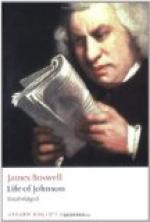My survey of Rasay did not furnish much which can interest my readers; I shall therefore put into as short a compass as I can, the observations upon it, which I find registered in my journal. It is about fifteen English miles long, and four broad. On the south side is the laird’s family seat, situated on a pleasing low spot. The old tower of three stories, mentioned by Martin, was taken down soon after 1746, and a modern house supplies its place. There are very good grass-fields and corn-lands about it, well-dressed. I observed, however, hardly any inclosures, except a good garden plentifully stocked with vegetables, and strawberries, raspberries, currants, &c.
On one of the rocks just where we landed, which are not high, there is rudely carved a square, with a crucifix in the middle. Here, it is said, the Lairds of Rasay, in old times, used to offer up their devotions. I could not approach the spot, without a grateful recollection of the event commemorated by this symbol.
A little from the shore, westward, is a kind of subterraneous house. There has been a natural fissure, or separation of the rock, running towards the sea, which has been roofed over with long stones, and above them turf has been laid. In that place the inhabitants used to keep their oars. There are a number of trees near the house, which grow well; some of them of a pretty good size. They are mostly plane and ash. A little to the west of the house is an old ruinous chapel, unroofed, which never has been very curious. We here saw some human bones of an uncommon size. There was a heel-bone, in particular, which Dr. Macleod said was such, that if the foot was in proportion, it must have been twenty-seven inches long. Dr. Johnson would not look at the bones. He started back from them with a striking appearance of horrour[502]. Mr. M’Queen told us it was formerly much the custom, in these isles, to have human bones lying above ground, especially in the windows of churches. On the south of the chapel is the family burying-place. Above the door, on the east end of it, is a small bust or image of the Virgin Mary, carved upon a stone which makes part of the wall. There is no church upon the island. It is annexed to one of the parishes of Sky; and the minister comes and preaches either in Rasay’s house, or some other house, on certain Sundays. I could not but value the family seat more, for having even the ruins of a chapel close to it. There was something comfortable in the thought of being so near a piece of consecrated ground.[503] Dr. Johnson said, ’I look with reverence upon every place that has been set apart for religion;’ and he kept off his hat while he was within the walls of the chapel[504].




